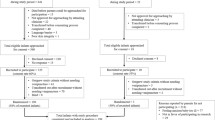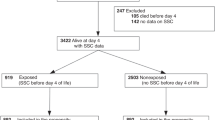Abstract
Objective:
To examine if single skin cleansing with 0.25% chlorhexidine affects skin condition, temperature and bacterial colonization in stable preterm (28–36 weeks gestational age) low birth weight (1001–2000 g) infants admitted in a health facility.
Methods:
Eligible infants were randomized within 3 h of birth into the following three groups: chlorhexidine, normal saline or no skin cleansing. Infants in the first two groups were wiped once with baby wipes containing either 0.25% chlorhexidine or saline. Skin condition, axillary temperature and skin colonization rates in the axilla and the groin were assessed at specified time intervals after intervention.
Results:
In all, 60 infants were included in the study (20 in each group). Median skin condition scores at 72 and 168 h after the intervention were 2 and 2, respectively, in all three groups. At 30 min after skin cleansing, two infants each in the chlorhexidine and saline cleansing groups and none in the no cleansing group experienced cold stress (36–36.4 °C). There was, however, no difference in mean skin temperature of the groups (36.6 °C). At 24 h, skin colonization rates in the axilla were 22.2, 52.7, and 57.9%, respectively, in the chlorhexidine, saline and no cleansing groups (P=0.06); skin cleansing with chlorhexidine reduced the incidence of colonization by 62% compared with no cleansing (relative risk (RR): 0.38, 95% confidence interval (CI): 0.15, 0.98), but there was no significant reduction when compared with saline cleansing (RR: 0.42; 0.16–1.10). Axillary colonization rates at 72 h and colonization at the groin at 24 and 72 h were not significantly different across the three groups.
Conclusion:
Single skin cleansing with 0.25% chlorhexidine did not adversely affect skin condition or temperature in hospitalized preterm infants and reduced axillary-skin colonization at 24 h after the intervention. Trials are needed to evaluate the efficacy of such an intervention on the incidence of infections in preterm neonates.
This is a preview of subscription content, access via your institution
Access options
Subscribe to this journal
Receive 12 print issues and online access
$259.00 per year
only $21.58 per issue
Buy this article
- Purchase on Springer Link
- Instant access to full article PDF
Prices may be subject to local taxes which are calculated during checkout

Similar content being viewed by others
References
Carey AJ, Saiman L, Polin RA . Hospital-acquired infections in the NICU: epidemiology for the new millennium. Clin Perinatol 2008; 35: 223–249.
Kumar M, Paul VK, Kapoor SK, Anand K, Deoraria AK . Neonatal outcomes at a subdistrict hospital in north India. J Trop Pediatr 2002; 48: 43–46.
Investigators of the National Neonatal Perinatal Database, National Neonatology Forum of India. Morbidity and mortality among outborn neonates at ten tertiary care institutions in India during the year 2000. J Trop Pediatr 2004; 50: 170–174.
Choi Y, Saha SK, Ahmed AS, Law PA, Chowdhury MA, Islam M et al. Routine skin cultures in predicting sepsis pathogens among hospitalized preterm neonates in Bangladesh. Neonatology 2008; 94: 123–131.
Darmstadt GL, Dinulos JG . Neonatal skin care. Clin Pediatr 2000; 47: 757–782.
Darmstadt GL, Saha SK, Ahmed AS, Chowdhury MA, Law PA, Ahmed S et al. Effect of topical treatment with skin barrier-enhancing emollients on nosocomial infections in preterm infants in Bangladesh: a randomized controlled trial. Lancet 2005; 365: 1039–1045.
Darmstadt GL, Badrawi N, Law PA, Alam A, Ahmed S, Husein MH et al. Topical therapy with sunflower seed oil prevents nosocomial infections and mortality in premature babies in Egypt: a randomized, controlled clinical trial. Pediatr Infect Dis J 2004; 23: 719–725.
Mullany LC, Khatry SK, Sherchand JB, LeClerq SC, Darmstadt GL, Katz J et al. A randomized controlled trial of the impact of chlorhexidine skin cleansing on bacterial colonization of hospital-born infants in Nepal. Pediatr Infect Dis J 2008; 27: 505–511.
Taha TE, Biggar RJ, Broadhead RL, Mtimavalye LA, Justesen AB, Liomba GN et al. Effect of cleansing the birth canal with antiseptic solution on maternal and newborn morbidity and mortality in Malawi: clinical trial. BMJ 1997; 3125: 216–219.
Tielsch JM, Darmstadt GL, Mullany LC, Khatry SK, Katz J, LeClerq SC et al. Impact of newborn skin-cleansing with chlorhexidine on neonatal mortality in southern Nepal: a community-based, cluster-randomized trial. Pediatrics 2007; 119: e330–e340.
Garland JS, Alex CP, Mueller CD, Otten D, Shivpuri C, Harris MC et al. A randomized trial comparing povidone-iodine to a chlorhexidine gluconate-impregnated dressing for prevention of central venous catheter infections in neonates. Pediatrics 2001; 107: 1431–1436.
Mullany LC, Darmstadt GL, Khatry SK, LeClerq SC, Tielsch JM . Safety of neonatal skin cleansing in rural Nepal. Indian Pediatr 2006; 43: 117–124.
Lane AT, Drost SS . Effects of repeated application of emollient cream to premature neonates’ skin. Pediatrics 1993; 92: 415–419.
World Health Organization. Thermal Protection in the Newborn: A Guide. Geneva, 1997. Report No. WHO/RHT/MSM/97.2.
Sankar MJ, Agarwal R, Deorari AK, Paul VK . Sepsis in the newborn. Indian J Pediatr 2008; 75: 261–266.
Rotimi VO, Duerden BI . The development of the bacterial flora in normal neonates. J Med Microbiol 1981; 14: 51–62.
Gezon HM, Thompson DJ, Rogers KD, Hatch TF, Rycheck RR, Yee RB . Control of staphylococcal infections and disease in the newborn through the use of hexachlorophene bathing. Pediatrics 1973; 51: 331–344.
Cowen J, Ellis SH, McAinsh J . Absorption of chlorhexidine from the intact skin of newborn infants. Arch Dis Child 1979; 54 (5): 379–383.
Meberg A, Schoyen R . Bacterial colonization and neonatal infections. Effects of skin and umbilical disinfection in the nursery. Acta Pediatr Scand 1985; 74: 366–371.
Darmstadt GL, Hossain MM, Choi Y, Shirin M, Mullany LC, Islam M et al. Safety and effect of chlorhexidine skin cleansing on skin flora of neonates in Bangladesh. Pediatr Infect Dis J 2007; 26: 492–495.
Mullany LC, Darmstadt GL, Khatry SK, Katz J, LeClerq SC, Shrestha S et al. Topical applications of chlorhexidine to the umbilical cord for prevention of omphalitis and neonatal mortality in southern Nepal: a community-based, cluster-randomised trial. Lancet 2006; 367: 910–918.
Da Cunha ML, Procianoy RS, Franceschini DT, De Oliveira LL, Cunha ML . Effect of the first bath with chlorhexidine on skin colonization with Staphylococcus aureus in normal healthy term newborns. Scand J Infect Dis 2008; 40: 615–620.
da Cunha ML, Procianoy RS . Effect of bathing on skin flora of preterm newborns. J Perinatol 2005; 25: 375–379.
Hall SL, Hall RT, Barnes WG, Riddell S . Colonization with slime-positive coagulase-negative staphylococci as a risk factor for invasive coagulase-negative staphylococci infections in neonates. J Perinatol 1988; 8: 215–221.
Stoll BJ, Hansen N, Fanaroff AA, Wright LL, Carlo WA, Ehrenkranz RA et al. Late-onset sepsis in very low birth weight neonates: the experience of the NICHD Neonatal Research Network. Pediatrics 2002; 110: 285–291.
Evans ME, Schaffner W, Federspiel CF, Cotton RB, McKee Jr KT, Stratton CW . Sensitivity, specificity, and predictive value of body surface cultures in a neonatal intensive care unit. JAMA 1988; 259: 248–252.
Author information
Authors and Affiliations
Corresponding author
Rights and permissions
About this article
Cite this article
Sankar, M., Paul, V., Kapil, A. et al. Does skin cleansing with chlorhexidine affect skin condition, temperature and colonization in hospitalized preterm low birth weight infants?: a randomized clinical trial. J Perinatol 29, 795–801 (2009). https://doi.org/10.1038/jp.2009.110
Received:
Revised:
Accepted:
Published:
Issue Date:
DOI: https://doi.org/10.1038/jp.2009.110
Keywords
This article is cited by
-
Myelin toxicity of chlorhexidine in zebrafish larvae
Pediatric Research (2023)
-
Safety of chlorhexidine gluconate used for skin antisepsis in the preterm infant
Journal of Perinatology (2012)



